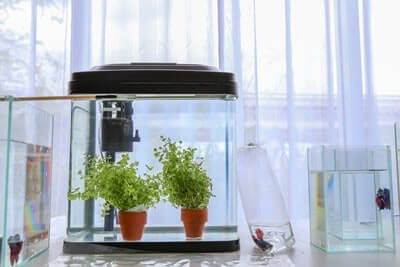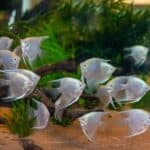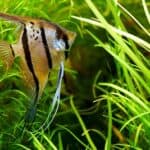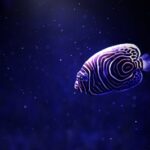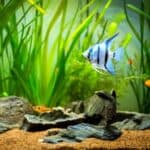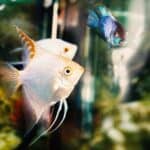Aquarium lighting isn’t just a stylish design feature but a practical necessity.
Plants and fish in the aquarium need ambient and artificial light to survive. Controlling it isn’t easy. Not only is insufficient light bad, but too much can unsettle the ecosystem.
Too much light is problematic in fish tanks. Aquarium plants tolerate light better than fish, using only the light they need to grow.
Algae feed off the excess nutrients, raising the ammonia to harmful levels. Algae growth puts plants at risk of dying as they coat the leaves, preventing them from being able to photosynthesize.
By providing the proper lighting for aquarium plants, the fish will benefit from the oxygen plants produce. They also remove CO2 from the water.
Can You Give Your Aquarium Too Much Light?
As described by Aquaculture and Fisheries, fish need light to grow and develop. Aquarium plants need light just as much as fish because they use it for photosynthesis.
Aquatic plants use aquarium lighting and natural sunlight to synthesize food from carbon dioxide and water. Algae also use light to grow.
Too much causes problems, but the correct levels help:
- Produce oxygen.
- Stabilize the tank’s ecosystem.
- Minimize the toxic levels of nitrogen in the water.
- Provides food for the tank’s fish and invertebrates.
Depending on the plant species in your tank, some need as much as 12 hours of light, but most require 8-10 hours daily.
If you use all 12 hours of aquarium lighting when the tank’s already in a bright and sunny room, you risk providing the plants and fish with too much light.
Too much light is bad for plants and fish because it causes stress and prevents them from being able to sleep. If you’re ever in doubt, emulate natural day-to-night conditions as closely as possible.
Is Too Much Light Bad For Aquarium Plants?
If you have too much light in your planted aquarium, your tank’s ecosystem will become unbalanced, affecting all life.
In most cases, plants only use the light they need, so they’re not directly affected. There’s no connection between the amount of light and the plant’s health.
Too much light causes the following problems:
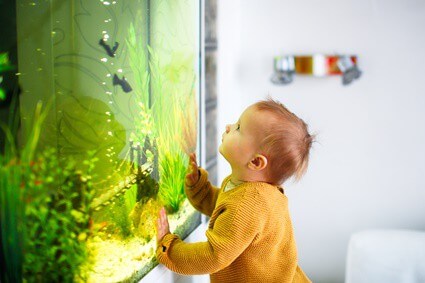
Algae Bloom
The more light you have in the tank, the more nutrients and CO2 the plants need to grow.
If your plants get too much light, they won’t be able to use them soon enough. As a result, algae feed off the excess nutrients and CO2, multiplying rapidly.
We’ve explained how a small amount of algae benefits aquariums. Too much, and the tank can go cloudy.
Fish also become sick. In the end, the consequence of too much light is that you end up feeding the algae, not the plants, causing an unstable environment for fish.
Fast-Growing Plants
When there’s too much light in the tank, the plants will grow much faster.
Plants that grow fast aren’t necessarily healthy – the two things aren’t directly linked. This means you’ll spend a long time trimming and pruning your plants to keep them at a suitable length.
Similarly, if the plants grow too much and too fast, there’s a risk that they may take up too much room, affecting the space your fish have to swim.
While fish enjoy having hiding spots, they must be able to swim amongst them freely.
Signs of Too Much Light on Aquarium Plants
Plants are hardy and can cope with unsuitable conditions for longer than fish can.
It can be tricky to tell when there’s too much light. However, there are ways to determine whether conditions aren’t quite right.
Pay attention to the following problems:
Algae Covering Plants
Plants under intense light will begin to develop a coating of algae.
That’s because the algae consume the excess nutrients the light produces, so they prefer the tank area that provides ideal conditions for them to grow.
Thankfully, it’s easy to clean algae off plants. If there’s a significant amount of algae, remove the plant (if you can) and gently scrub the algae off.
If it doesn’t come away, you can bleach the plant as a last-ditch attempt to save it. To do so:
- Use a 10% bleach solution and soak the plant for up to 5 minutes – no more.
- Remove the plant from the solution and rub the leaves to dislodge the algae.
- Submerge it in a tub or bucket of clean, conditioned water and let it soak for 10 minutes.
- Rinse it well and return it to the tank.
You may find that the plant’s already lost and died, but it’s worth a try, as it would die anyway.
Rotting Leaves
If algae start taking over the fish tank and grow on your plants, they can cause damage to your plants, choking the leaves and preventing them from absorbing the light they need.
Eventually, this will cause the plants to rot and die. You may notice holes in the leaves, or they could turn brown or yellow where the light absorption has become obstructed.
Stressed Fish
Just because plants don’t show signs of too much light immediately doesn’t mean they aren’t suffering.
One of the easiest ways to tell whether there’s too much light is to monitor your fish, as they’ll exhibit signs of distress, including:
- Aggression.
- Decreased appetite.
- Diseases, such as ich.
- Jumping out of the tank.
- Poor scale quality.
- Weight problems.
This is because, for fish, too much light:
- Limits the amount of available oxygen.
- Causes dangerous and potentially harmful ammonia spikes.
- It makes the tank dirty and unclean.
If you suspect too much light, these signs will help you decide.
What Is the Best Light for Aquarium Plants?
To grow properly and be healthy, aquarium plants require lighting with the right spectrum.
Many aquariums come with a lighting package, but the spectrum they need isn’t quite right. Instead, they swap the lights out for lights with dedicated plant spectrums.
The color of the light is measured in Kelvin, and most plant lights have a rating between 6500k and 9000k. The lower end of the scale has a yellow hue, while the higher end has a whiter shade.
Plants enjoy the red spectrum of light the most, which is as low on the Kelvin spectrum as 3000k. However, this isn’t as aesthetically pleasing, so many owners don’t use it.
The best way to encourage plant growth and bring out the colors of the fish and plants is to use a mixture of lamps with red, blue, and green in their spectrum.
The following lights can produce this:
Fluorescent Bulbs
T5 and T8 fluorescent bulbs are the most common forms of aquarium lighting.
Both have plant-growing capabilities, but T5s are universally recommended because they’re more powerful and are better for plants that are planted more densely.
If you have demanding aquarium plants, you might need two T5 bulbs to do the job.
When using T5 bulbs, consider these wattage levels as a rough guideline:
- Low Lighting: 0.25 Watts per Liter. Suitable for easy plants.
- Medium Lighting: 0.50 Watts per Liter. Ideal for medium plants.
- High Lighting: 0.80 – 1.0>. Suitable for hard plants.
LEDs
If you only have a few plants in the tank, LEDs are recommended.
They require little energy to run and use up to 80% less energy than other bulbs. They don’t generate as much heat as fluorescent lights, so you don’t have to worry about rising water temperatures.
Another benefit is that LEDs last for up to 50,000 hours, which equates to 6 years, saving you money on replacement bulbs. If you have many plants in the tank, LEDs won’t be bright enough.
Metal Halides
If you have a reef aquarium needing high light levels, metal halides are recommended. They’re the choice of experienced fish keepers and comprise a primary glass bulb connected to an arc tube.
One thing to watch out for is that metal halides get hot. This isn’t all bad, as it means they could be a good solution for maintaining the heat of a tropical tank.
What’s The Difference Between Aquarium Light vs. Grow Light
The main difference between standard aquarium lights and grow lights is the spectrum of light they emit. They also have different Kelvin rating, which measures the color temperature of the light bulb:
- Grow lights: Red, blue, and UV spectrum. 4,700k to around 6,700k.
- Aquarium lights: Full range of the white spectrum.
Grow lights create an artificial light source that supports the chemical process of photosynthesis, allowing plants to convert light into the energy they need to grow and produce.
Aquarium lights have more green and less red and blue. They produce a more pleasing illumination but are unsuitable for growing plants because they don’t have enough red and blue light.
How Long To Leave Aquarium Lights on Planted Tanks
Most fish tanks need 8-12 hours of light for the aquatic plants to thrive. 10 hours is a good starting point for aquarium lights. This is a broad range, and every plant’s lighting needs differ.
To work out how much light you need for your aquarium, consider:
- The number of plants you have.
- The plant species.
- The amount of natural sunlight or ambient light is already in the room.
- The species of fish in the tank.
- The number of algae present.
Plants use aquarium lighting and ambient light to photosynthesize.
If your room gets lots of sunlight, supplementing it with aquarium light for 12 hours might be too much. You may not need additional aquarium lighting at all.
Similarly, if you only have a few plants in the tank, you don’t need as much light. In this case, prioritize how much light your fish need.
To provide the best conditions for all life in the tank, match the plants with the type of fish you have. For example, tropical fish aquariums require tropical plants.
Cold-water tanks need plants that thrive in cooler waters. Set the light levels to match the natural environment your plants come from.
To summarize, use this lighting schedule as a rough guide for the tank:
- Average aquarium: 10 hours of light a day.
- Tropical aquarium: 12 hours of light a day.
- Cold water aquarium: 8 hours of light a day.
- No plants: far less light required.
Is Blue Light Good for Aquarium Plants?
According to Michigan State University, aquatic plants need 50% red light, 35% green light, and no more than 15% blue light for healthy growth.
Most red light is absorbed in the water surface, while blue light penetrates the deepest. Green sits somewhere in the middle. Plants use a type of blue light called actinic blue.
It makes plants bushy and leafy and targets the plant leaves and stems. It helps mimic a moonlight environment and marks the transition between dawn and dusk, benefitting all inhabitants.
When blue and red lights are used together, aquarium plants grow strong. It also doesn’t contribute to algae growth.
What Are Good Beginner Aquatic Plants?
If you’re looking to start with some easy beginner plants to grow and keep alive alongside your fish, the following are simple to care for:
Java Fern
Java fern can’t be buried into the substrate, but you can tie it around driftwood or ornaments. Secure it with black cotton thread, and the roots will attach to the object after a few weeks.
Java fern is slow-growing and reaches around 13 inches.
Fish enjoy swimming and hiding amongst the leaves. It’s also easy to care for and only requires low to moderate light levels, growing well without additional nutrients or CO2.
Java Moss
Java moss and java fern are similar. Moss is more effective at hiding newborn fry because it’s bushy and covers everything within the tank.
It can take over the aquarium if you don’t trim it back occasionally.
Like java fern, you can tie java moss to driftwood so that it floats, providing fish with hiding opportunities.
The plant also creates a carpet on the bottom of the tank. This provides shelter for fish looking for additional food in the substrate, protecting them from other fish competing for food.

Hornwort
Hornwort is among the tallest growing aquarium plants and works well at the back of the tank, where it provides shelter for both fish and their eggs.
When planted in dense plant groups, fish love to take cover amongst the stems. Hornwort is also an oxygenator and provides fish with a healthy supply of natural H2O.
Hornwort requires moderate to bright lighting and a generous amount of liquid fertilizer to remain healthy. It also grows fast, requiring trimming to prevent it from taking over the tank.
Anubias Nana
Anubias nana complements tall green plants as it grows lower than other aquatic plants.
It grows wide rather than tall, protecting fish that bury themselves in the substrate. It can survive in low-light conditions and doesn’t require much to produce.
The leaves attract algae over time, but you can clean them during a water change to prevent overgrowth. Be careful how much light you provide the Anubias nana to minimize algae growth.
If planting it into the substrate, place each one approximately two inches apart, giving them access to available light. It’s a great plant to have at the front of the aquarium.
Vallisneria
Vallisneria is inexpensive, low maintenance, and easy to care for.
You only need a small branch for it to grow dense and luscious. Vallisneria is ideal for wider aquariums that allow fish to remain near the substrate.
While Vallisneria prefers bright lights, it can still grow in tanks with lower levels – it’ll have a slower growth rate.
There are three different types of Vallisneria:
- Vallisneria spiralis: This is long and straight, like tall blades of grass.
- Vallisneria Americana: This has long, thicker leaves and is known as the “jungle val.”
- Vallisneria Asiatica: This has twisted spiral leaves.
Aquarium lighting is often overlooked, and it benefits plants and fish. Looking after the plants means the fish are naturally cared for and have everything they need to survive.

